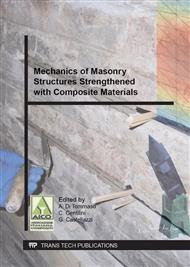[1]
G. Salerno and G. de Felice, Continuum modeling of periodic brickwork, Int. J. Solids Struct., vol. 46, no. 5, p.1251–1267, Mar. (2009).
DOI: 10.1016/j.ijsolstr.2008.10.034
Google Scholar
[2]
A. Pau and P. Trovalusci, Block masonry as equivalent micropolar continua: the role of relative rotations, Acta Mech., vol. 223, no. 7, p.1455–1471, May (2012).
DOI: 10.1007/s00707-012-0662-8
Google Scholar
[3]
P. Trovalusci and A. Pau, Derivation of microstructured continua from lattice systems via principle of virtual works: the case of masonry-like materials as micropolar, second gradient and classical continua, Acta Mech., vol. 225, no. 1, p.157–177, Aug. (2013).
DOI: 10.1007/s00707-013-0936-9
Google Scholar
[4]
J. Sulem and H. Mühlhaus, A continuum model for periodic two-dimensional block structures, Mech. Cohesive Frict. Mater., vol. 2, no. March 1996, p.31–46, (1997).
DOI: 10.1002/(sici)1099-1484(199701)2:1<31::aid-cfm24>3.0.co;2-o
Google Scholar
[5]
I. Stefanou, J. Sulem, and I. Vardoulakis, Three-dimensional Cosserat homogenization of masonry structures: elasticity, Acta Geotech., vol. 3, no. 1, p.71–83, Feb. (2008).
DOI: 10.1007/s11440-007-0051-y
Google Scholar
[6]
M. Godio, Etude théorique et numérique du comportement dynamique tridimensionnel des structures en maçonnerie, MSc Thesis ENPC, (2012).
Google Scholar
[7]
J. Simo, J. G. Kennedy, and S. Gonvindjee, Non-smooth multisurface plasticity and viscoplasticity. Loading/unloading conditions and numerical algorithms, Int. J. Numer. Methods Eng., vol. 26, no. June 1987, p.2161–2185, (1988).
DOI: 10.1002/nme.1620261003
Google Scholar
[8]
R. de Borst, Simulation of strain localization: a reappraisal of the Cosserat continuum, Eng. Comput., vol. 8, no. 4, p.317–332, (1991).
DOI: 10.1108/eb023842
Google Scholar
[9]
D. Addessi, A 2D Cosserat finite element based on a damage-plastic model for brittle materials, Comput. Struct., vol. 135, p.20–31, Apr. (2014).
DOI: 10.1016/j.compstruc.2014.01.003
Google Scholar
[10]
P. Trovalusci and R. Masiani, Material symmetries of micropolar continua equivalent to lattices, Int. J. Solids Struct., (1999).
DOI: 10.1016/s0020-7683(98)00073-0
Google Scholar
[11]
P. Trovalusci and R. Masiani, Non-linear micropolar and classical continua for anisotropic discontinuous materials, Int. J. Solids Struct., vol. 40, no. 5, p.1281–1297, Mar. (2003).
DOI: 10.1016/s0020-7683(02)00584-x
Google Scholar
[12]
D. Addessi, E. Sacco, and A. Paolone, Cosserat model for periodic masonry deduced by nonlinear homogenization, Eur. J. Mech. - A/Solids, vol. 29, no. 4, p.724–737, Jul. (2010).
DOI: 10.1016/j.euromechsol.2010.03.001
Google Scholar
[13]
D. Addessi and E. Sacco, A multi-scale enriched model for the analysis of masonry panels, Int. J. Solids Struct., vol. 49, no. 6, p.865–880, Mar. (2012).
DOI: 10.1016/j.ijsolstr.2011.12.004
Google Scholar
[14]
D. Baraldi, E. Reccia, A. Cazzani, and A. Cecchi, Comparative Analysis of Numerical Discrete and Finite Element Models: the Case of in-Plane Loaded Periodic Brickwork, Compos. Mech. Comput. Appl. An Int. J., vol. 4, no. 4, p.319–344, (2013).
DOI: 10.1615/compmechcomputapplintj.v4.i4.40
Google Scholar
[15]
E. Reccia, A. Cazzani, and A. Cecchi, FEM-DEM Modeling for Out-of-plane Loaded Masonry Panels: A Limit Analysis Approach, Open Civ. Eng. J., p.231–238, (2012).
DOI: 10.2174/1874149501206010231
Google Scholar
[16]
K. Sab, J. Dallot, and A. Cecchi, Determination of the overall yield strength domain of out-of-plane loaded brick masonry, Int. J. Multiscale Comput. Eng., (2007).
DOI: 10.1615/intjmultcompeng.v5.i2.20
Google Scholar
[17]
Itasca Consulting Group, 3DEC 5. 0., Minneapolis, (2013).
Google Scholar
[18]
P. Cundall, Formulation of a three-dimensional distinct element model—Part I. A scheme to detect and represent contacts in a system composed of many polyhedral blocks, Int. J. Rock Mech. Min. …, vol. 25, no. 3, p.107–116, (1988).
DOI: 10.1016/0148-9062(88)92293-0
Google Scholar
[19]
J. V. Lemos, Discrete Element Modeling of Masonry Structures, Int. J. Archit. Herit., vol. 1, no. 2, p.190–213, May (2007).
Google Scholar


